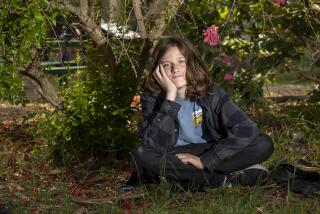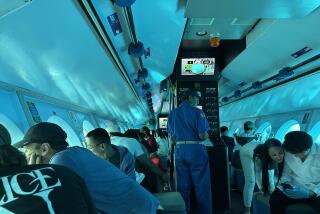Yellow Sub Gets to Bottom of Environmental Scene : Education: High school students travel to the sea floor for hands-on research experience. Inner-city youths will be among the participants.
- Share via
BENEATH THE GULF OF MAINE — As the yellow-hulled Delta slips below the surface in the Gulf of Maine 22 miles off Massachusetts, bubbles form outside the portholes. The submersible craft enters a different world.
The tiny, two-person sub dives to the sea floor, scattering fish as it skims the bottom noiselessly, moving through rocky canyons. This once-in-a-lifetime experience 200 feet underwater is part of high school program designed to bring the reality of the ocean and the environment up close.
“Don’t be scared!” the pilot barks at a reporter as the sub hits the edge of a sharp ledge and bounces off, backwards, into a murky crevasse. “It sounds bad, but nothing’s gonna break.”
As the sub meanders along the bottom, an unfamiliar realm slowly comes to life. Vivid pink and red stems of algae rise from the rough sand and flutter eerily, like long-stemmed roses. Ivory-colored sponges decorate the black, craggy rocks.
Flounder swim lazily past the portholes. An enormous skate, lying flat on the bottom like a gray rug, heaves awake under sub’s bright floodlights and circles the craft in apparent irritation.
The High School Aquanaut program allows students and their teachers to participate in real undersea research in the waters off southern New England, the mid-Atlantic Bight and the Laurentian Great Lakes.
“I couldn’t believe what I was seeing,” said Mary Wohlleber, 17, who will be a freshman at Eastern Connecticut State University next year. She has made two dives. “It makes you appreciate the ocean more. You’re there doing the work firsthand, and until you do it firsthand you don’t respect the animals or their environment.”
The program is sponsored by the federally supported National Undersea Foundation at the University of Connecticut. The students are from southeastern Connecticut high schools, and there are plans to include inner-city students from New York next year.
“There’s no better way to get youngsters excited about the ocean and the environment than to make them diving scientists,” Richard A. Cooper, director of the National Undersea Research Center, said.
The course is safe, too. The Delta has made 1,969 dives without an accident. The sub is made of reinforced steel and is equipped with the same type of battery that powers a golf cart. It can go down 1,200 feet without pressurized air.
Students in the program, now in its third year, take part in research experiments. They are selected on a competitive basis from their schools, and plan their individual projects with their teachers and program coordinators before they go to sea.
“It was the experience of a lifetime,” 17-year-old Brad Martin said. “The views, the crew, being in a place that not many others are able to travel and explore. The program has been a dream come true.”
In the so-called Pigeon Hill area at Jeffrey’s Ledge off Gloucester, students help marine biologists measure the pollution content of scallops to determine the contamination of surface sediments. They set scallop cages and later retrieve them with the aid of the Delta’s mechanical arm.
“We want to make them see that it takes only a short time to pollute the planet and several thousand years to reverse the process,” said Cooper.
Data from the scallop samples also have a larger significance, said Bill Robinson, a marine biologist with the New England Aquarium who is a program coordinator.
“We know more about corn in the Midwest than we do about fish in the ocean,” he said. “That’s why we can harvest corn so well. We don’t know anything about scallops, but once we know about their reproduction cycles, it’ll make all the difference.”
Singer Richie Havens was aboard the research vessel J.W. Powell recently as it left Gloucester with a group of scientists and teachers to discover firsthand how the program works.
Havens, 49, grew up in Brooklyn and works with underprivileged students in New York City. He helped to found the Northwind Undersea Institute for children on City Island in the Bronx. He also heads the Natural Guard, based in Washington, D.C., an environmental program for inner-city youths.
“I was a city kid, and city kids need a place to go away from the concrete,” said Havens, who said he will bring students into the program next year. “We’re trying to raise their consciousness about their environment by showing them something they wouldn’t otherwise see.”
More to Read
Sign up for Essential California
The most important California stories and recommendations in your inbox every morning.
You may occasionally receive promotional content from the Los Angeles Times.













